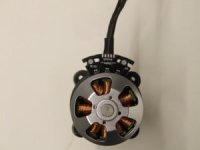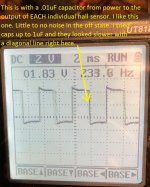Notes:DanGT86 said:This last pic is the hall signal from the 9c hub motor for comparison. It also seems to go under 4v in the on state but still looks cleaner and less noisy to my untrained eye (I borrowed the scope and have about 1 min of training on it)
1) That could be your scope probe picking up some of that through coupling to the power signal. So it may not be all real.
2) That could also be the phase (power) line coupling to the Hall sensor lead which is real. A stronger pullup will help there. Also, an RC filter might help on the signal itself. For example, a 100 ohm in series, and a .01uF from controller pin to ground (at the controller end not the motor end) would give you a filter at 150KHz which should help.
3) It might be noise on the 5V line but probably not. A 1uF or so ceramic (NOT electrolytic) cap between +5 and gnd at the Hall sensor may help there.












